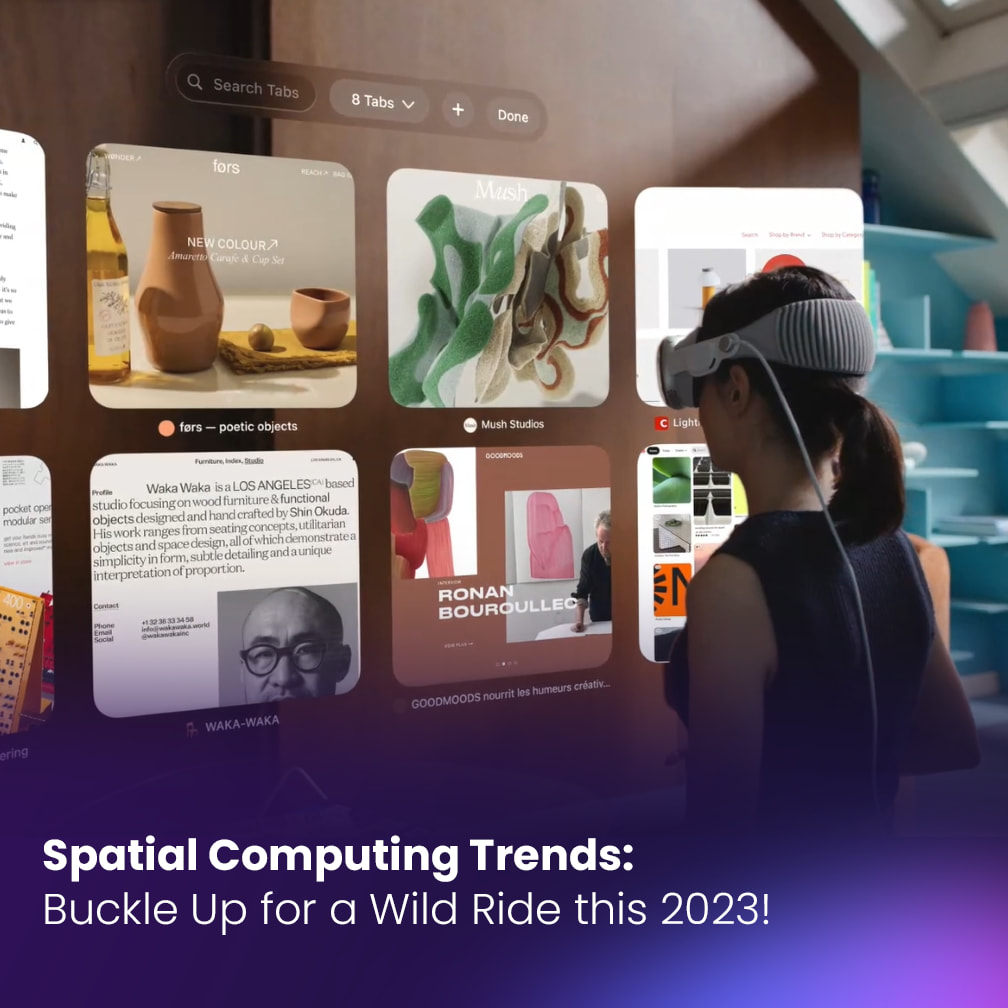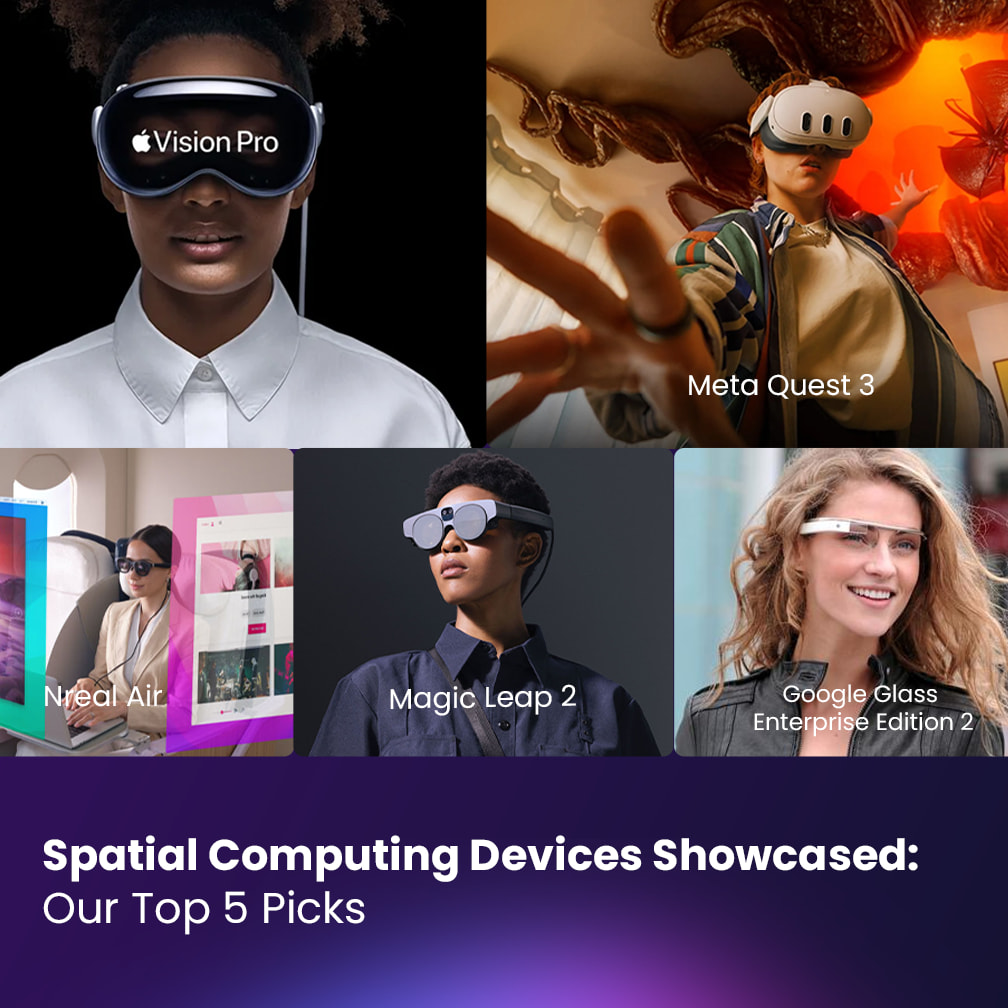Spatial Computing Trends: Buckle Up for a Wild Ride this 2023!
- admin
- December 11, 2023
- 3 Comments

Hold onto your virtual reality headsets, folks, because the trends of spatial computing are about to take us on a wild ride! We’re talking about blurring the lines between the real and digital worlds, where virtual experiences become so immersive and interactive that they feel indistinguishable from reality.
But don’t just take our word for it. Let’s dive into some of the hottest trends driving the spatial computing revolution:
Table of contents
- The Rise of the Apple® Vision Pro
- Stage Meta: Democratizing Access to the Spatial Computing Spaces
- From Entertainment to Education: Spatial Computing Goes Mainstream
- Hyperconnectivity: Spatial Computing Gets Social
- From Gimmicks to Everyday Essentials
- The Rise of Spatial Worlds
- The Blurring Lines between the Real and Virtual
- The Era of Spatial Commerce
- Decentralized Ownership and Spatial Computing
- The Ethical Considerations of Spatial Computing
- Are You Ready to Dive into the Spatial Computing Revolution?
The Rise of the Apple® Vision Pro
Apple® is known for its sleek and user-friendly gadgets, and they’re set to shake up the spatial computing landscape with their highly anticipated Apple® Vision Pro headset.
This lightweight, powerful headset promises to offer seamless integration with Apple®’s ecosystem, making it a game-changer for Apple® users and developers alike. Imagine attending virtual meetings, collaborating on projects in real-time, or exploring immersive worlds – all from the comfort of your own living room.
Stage Meta: Democratizing Access to the Spatial Computing Spaces
Remember those futuristic movies where people walked around virtual worlds with personalized avatars? Well, Stage Meta is making that a reality for everyone, not just techy wizards.
This innovative platform provides the tools and resources for anyone to create their own Spatial World, regardless of their technical expertise. It’s like having your own virtual canvas, where you can unleash your creativity and build anything you can imagine.
From Entertainment to Education: Spatial Computing Goes Mainstream
The applications of spatial computing are no longer limited to gaming and entertainment. Educators are harnessing the power of VR and AR to create engaging and interactive learning experiences that bring subjects to life.
Imagine students dissecting virtual frogs, exploring ancient civilizations in 3D, or practicing surgical procedures in a safe and controlled environment.
Hyperconnectivity: Spatial Computing Gets Social
Picture this: you’re attending a virtual concert with your friends from across the globe, all dancing and interacting in real-time. This is the future of social interaction in spatial computing, where physical distance becomes irrelevant.
Platforms like Stage Meta are facilitating these hyperconnected experiences, allowing people to connect, collaborate, and create shared memories in ways never before possible.
From Gimmicks to Everyday Essentials
Remember those bulky VR headsets that were more of a novelty than a practical tool? Well, those days are over. The next generation of spatial computing devices is sleeker, more comfortable, and packed with powerful features that make them truly useful for everyday tasks.
Imagine using AR glasses to navigate unfamiliar city streets, get real-time translations while traveling abroad, or attend virtual meetings without ever leaving your home.
The Rise of Spatial Worlds
Spatial computing isn’t just about shared virtual experiences; it’s also about creating personalized havens. Imagine having your own virtual world, customized to your interests and preferences.
It could be your dream home, a hidden island getaway, or even a spaceship exploring the cosmos. The possibilities are endless, and the power to create these personalized spaces lies in your hands.
The Blurring Lines between the Real and Virtual
As technology advances, the lines between the real and virtual worlds will continue to blur. Imagine seamlessly transitioning between your physical environment and virtual experiences using your Apple® Vision Pro headset.
One moment you could be cooking dinner in your kitchen, and the next, you could be exploring a virtual rainforest or attending a concert in a virtual stadium.
The Era of Spatial Commerce
Get ready for a shopping experience revolution! Spatial computing will transform the way we shop, allowing us to try on clothes virtually, explore products in 3D, and even interact with virtual salespeople.
Imagine browsing a virtual mall, picking up a virtual dress to try on your avatar, and then purchasing it with a click of a button. This is the future of retail, and it’s happening right now.
Decentralized Ownership and Spatial Computing
The future of spatial computing is decentralized, where users have more control over their data and experiences. Platforms like Stage Meta are pioneering this approach, allowing users to own their Meta Worlds and manage their digital assets with complete autonomy.
This shift towards decentralization will empower users and create a more open and inclusive spatial computing.
The Ethical Considerations of Spatial Computing
As with any powerful technology, there are ethical considerations that need to be addressed. Issues like data privacy, virtual reality addiction, and the potential for misinformation require careful consideration and responsible development.
It’s important to approach the future of spatial computing with a thoughtful and ethical perspective.
The future of spatial computing is bright, exciting, and brimming with possibilities. Embracing it and utilizing platforms like Stage Meta, we can all be a part of shaping this groundbreaking technology and paving the way for a more immersive, connected, and personalized future.
TPALead
Are You Ready to Dive into the Spatial Computing Revolution?
The future of spatial computing is here, and it’s time to jump in! Whether you’re an early adopter eager to explore the possibilities or a business looking to gain a competitive edge, the opportunities are endless.
Here’s how you can be a part of this exciting spatial computing trends:
- Get informed: Stay up-to-date on the latest trends and advancements in spatial computing. Read articles, attend conferences, and connect with other enthusiasts.
- Experiment with different platforms: Try out different VR and AR headsets, explore platforms like Stage Meta, and discover the possibilities they offer.
- Develop your skills: Learn how to create 3D models, design virtual experiences, and utilize the tools available to build your own Meta World on Stage Meta.
- Get creative: Don’t be afraid to unleash your imagination! The possibilities are endless in spatial computing, so let your creativity run wild and build something truly unique.
- Connect with others: Join online communities and forums dedicated to spatial computing. Share your ideas, collaborate on projects, and learn from others.
By embracing spatial computing, you can unlock a world of possibilities. Whether you’re a gamer, a developer, an educator, or simply someone who wants to experience the future, spatial computing is a space for everyone.
So, what are you waiting for? Take the plunge and join the spatial computing revolution!
For more information and to dive deeper into the boundless possibilities of Stage Meta and TPA, visit Stage Meta’s Homepage. The future is now, and it awaits you.
Welcome to the new age of Spatial Computing. Welcome to Stage Meta.









3 Comments
[…] Spatial Computing Trends: Buckle Up for a Wild Ride this 2023! […]
[…] Spatial Computing Trends: Buckle Up for a Wild Ride this 2023! […]
[…] Spatial Computing Trends: Buckle Up for a Wild Ride this 2023! […]